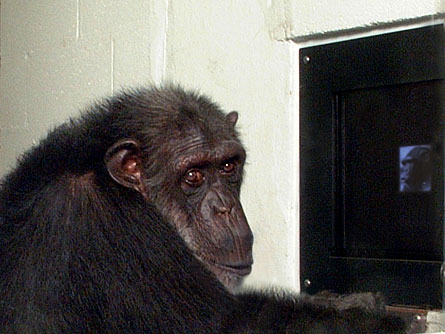The brain saves face similarly in chimpanzees and people, and possibly in macaque monkeys as well. Chimps recognize their compatriots’ faces by utilizing many of the same brain regions that have already been linked to people’s ability to identify familiar faces, a new study suggests.

Neural regions that enable efficient discrimination of one individual’s face from another’s may have evolved between 8 million and 6 million years ago in a common ancestor of chimps and humans, propose psychobiologist Lisa Parr of Emory University in Atlanta and her colleagues. Similar neural elements of face discrimination also appear in macaques, another study finds, suggesting that this ability evolved even earlier.
Parr’s group has already conducted studies indicating that chimps recognize other chimps’ faces nearly as well as people recognize other people’s faces. “For the most part, similar brain regions are responsible for this ability in chimps and humans,” Parr says. In her work, macaques’ proficiency at face recognition falls short of that displayed by chimps.
Parr’s new brain-scan investigation, published online December 18 in Current Biology, comes on the heels of evidence that a closer link exists between face-responsive parts of macaque and human brains than was previously suspected. Part of the brain known as the temporal lobe hosts a handful of face-sensitive regions in macaques and people, according to a team led by neuroscientist Doris Tsao of the University of Bremen in Germany. Parr’s group also found largely temporal-lobe responses in chimps.
Areas of macaque brains involved in face recognition are positioned in the temporal lobe somewhat differently than those of people are, Tsao’s group reports in the Dec. 9 Proceedings of the National Academy of Sciences. While there’s no evidence that specific face-sensitive areas in macaques and people carry out precisely the same duties, the macaque study still suggests a basic brain system for face recognition arose early in primate evolution, the scientists propose.
“Recognition of individuals by their faces probably depended on a specialized brain system in social primates that existed over at least the last 20 million years,” remarks neuroscientist Jon Kaas of Vanderbilt University in Nashville. That brain system provided a basis for more elaborate face-analysis mechanisms that evolved in chimps and humans, Kaas proposes.
Parr’s team examined brain responses in five chimps housed at a primate facility. The animals underwent positron emission tomography, or PET, scans, which track brain activity as reflected by the rate of blood-sugar metabolism in neural tissue. PET scans were obtained from anesthetized chimps just after they had been shown sets of three chimp faces from which they selected matching pairs of faces. In other trials, chimps identified matching pairs of inanimate objects.
Face recognition elicited pronounced activity in a cluster of temporal lobe sites and in a few spots at the front of the brain. In the human brain, most face-related activity has been observed in the temporal lobe. It’s not clear whether chimps possess a temporal-lobe structure that corresponds to a section of an inner-brain region called the fusiform gyrus, considered crucial for face recognition in humans, Parr notes.
Tsao’s team used a functional MRI scanner to track rises and falls in blood flow, which coincide with neural activity, in the brains of 10 macaques and 13 people. Surgical insertion of a scanner-compatible head post allowed brain imaging of monkeys as they viewed pictures of human faces, macaque faces, human hands, gadgets, fruits and vegetables, and scrambled patterns.
Signature activity spikes in the temporal lobe occurred only in response to faces, with macaques and people displaying stronger neural reactions to members of their respective species.







